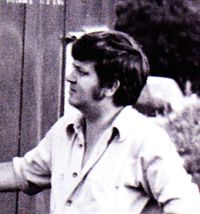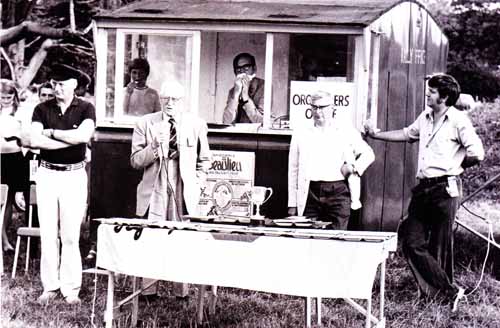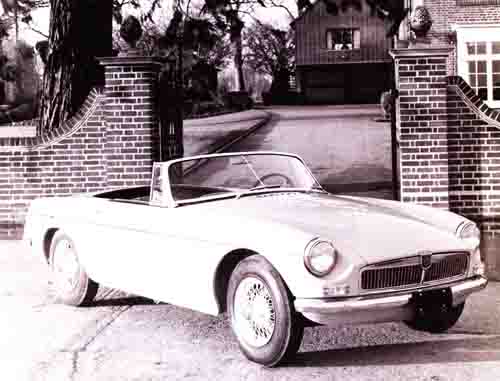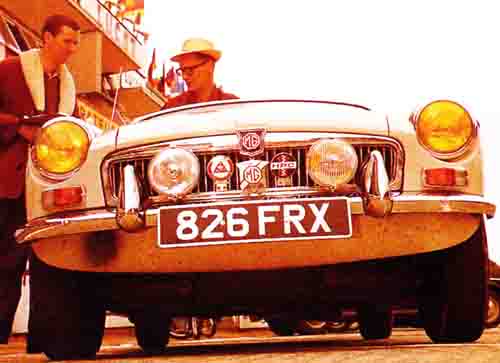History of the MG Car Club: Part 7

 Part 7 of this multi-part series of the MG Car Club History covers the late Sixties from 1968 – 1970. Martin Brent was MG Car Club General Secretary during this turbulent period.
Part 7 of this multi-part series of the MG Car Club History covers the late Sixties from 1968 – 1970. Martin Brent was MG Car Club General Secretary during this turbulent period.
When British Leyland closed down Safety Fast! and the MG Car Club operations, as one who was most intimately concerned in both events, I must tell the story as it was and record the immense contribution that one Gordon Cobban made to the future of the Club.
What really happened is that in the summer of 1968, shortly after we had learnt that Safety Fast! was to be chopped and replaced by the new Leyland magazine High Road, Wilson McComb called Les Needham of the Austin-Healey Club, Maurice Burlon of the Mini 7 Club and yours truly, who was dealing with matters pre-1955 MG, into his office and broke the news that the car clubs were to be axed. The reactions varied; Maurice was furious as he had just, that month relocated his family from Essex, while Les was, as usual, calm and collected. Me – well I wondered what the future held for me, but I had had a year or two of fun, I was young and in love…

Wilson next spoke with me about the future of the MG Car Club and related the discussions that he had had with John Thornley. It seemed that JWT (who was very poorly at the time) was looking at ways to save the Club and had been talking to the Club’s elder statesmen, particularly Gordon Cobban, then Secretary of the South East Centre. As I recall, Wilson was not terribly happy about Gordon’s plans for the continuation of the MGCC and had his own ideas.
Wilson was playing his cards close to his chest but I know (because I saw the final draft of his proposals) that he had discussions with the VSCC about their structure and how it worked. Wilson’s proposals were based on that sort of structure, suitably modified to cater for the existing structure of the MGCC, and envisaged a new Club office staffed by Wilson and myself, aided and abetted by Margret O’Brien who was supremo in the Club Office, dealing with membership administration. The Centres and the Registers would continue but the Registers might have had an enhanced role. The finances seemed to add up and Wilson worked it up for a meeting with JWT and Gordon when the matter was to be discussed.
I can clearly recall the afternoon of that meeting as Gordon burst into the office with a big grin on his face and, as he passed my desk, said, “Don’t worry, it’s all in here.”
What transpired at the meeting I knowest not but Wilson returned somewhat downcast and Gordon ####-a-hoop. Whatever happened, Wilson’s proposals never again saw the light of day. Shortly after this I was called to JWT’s presence and asked about my personal future.
The simple stark choice was to either take the MG files to Cowley and continue my service work from there or to hand the work over to the MGCC Registers and be relocated at Abingdon doing something else. If the latter, what did I want to do? I said that I did not want to go to Cowley and that I would like to stay at Abingdon – perhaps try my hand at factory planning – which is how I eventually found myself in the work study section!
Wilson, too, was looking to his future, and amongst other things he mentioned that he had been approached by the Montagu Motor Museum about employment but had decided to go off and finish his magnum opus – MG by McComb – and then freelance.
The decision made on my employment, JWT asked me to discuss the handover of the files and the service enquiries to the Club. I thus found myself talking to Gordon and Mike Allison and it was agreed that Registers would, in future, deal with all pre-1955 service queries addressed to BMC/BL. One of the associated matters discussed was the security of the files, which had, until then, been very secure with only the Car Club office staff having access. These files, in two filing cabinets, contained a huge collection of MG memorabilia started by George Tuck and added to over the years by his successors and by Wilson, Mike and myself.
One of the joys of working at Abingdon was that employees seemed to hoard everything from pre-war service tools, which were still available on loan to staff, to manuals, publicity material and pictures.
The arrival of my VA in the factory car park was used as an excuse by many to clear out all manner of drawers and odd corners greatly to the benefit of the Club, and where there were duplicates, my own personal files. Also, at this time, I was spending a lot of time over at Cowley Photographic going through the negatives of the old drawing office records and listing them (l was also getting a lot of copy material for both the Club and my personal SVW files!). The material in this collection was fantastic – I found many gems, such as Kimber’s drawings for his dissertation on style, drawings for models that never saw the light of day and much, much more, mostly, it has to be said, of a fairly mundane nature but of great interest to owners rebuilding their pre-war cars. My only wish was that l could have had more time to go through it properly but, as they say, the clock was ticking.
The two four-drawer cabinets full to the brim with irreplaceable material and previously mentioned, were supplemented by two other cabinets in Wilson’s office which were mainly photographs of races, trials, hill climbs and other events that he had assembled over the years as Editor of and subsequently as Gen. Sec of the Car Club. Why all this detail? Well, read on.
I don’t know why, but the agreement with the Club was that the two primary filing cabinets and the individual model files were to be handed over to the Club and that the Club was to be responsible for their security. All other material was to be disposed of or reallocated. It was at this time that Wilson and I had our one and only really memorable argument. He suddenly told me that as Secretary of the Vintage Register he felt that the Members of that Register were getting a raw deal and that he was contemplating either persuading the members to go independent or to join the VSCC. I was strongly of the opinion that the crisis facing the Club was such that we needed solidarity rather than divisiveness and told him so in no uncertain terms. To say that he went ballistic is an understatement but typically, after we had both shouted at each other for a few minutes, it all blew over and by the afternoon all was back on an even keel and the Vintage Register stayed with the Club – for the time being.
It was shortly after this that Wilson went off on leave, the other occupants of the office were relocated and I was left with the melancholy task of watching over the clearance of the Club and Safety Fast! offices. A skip arrived and the stuff that went into it was astounding. The collected junk of 25 years was dragged out of corners and after a quick look to see if it might be needed, it went either into a box for safe keeping or into a barrow and thus to the skip. So much of it would now be priceless to the collector. When I saw the two supplementary filing cabinets from Wilson’s office heading for the skip I moved quickly to stop the barrow. I asked what was happening, “Mr. Lambourne (then Works Manager) wants this cleared,” was the response. Off I rushed to JWT who, in effect, said that he didn’t care what happened to those particular files as long as the office was cleared – anyone who wanted them could have them! Remember, he was not a well man and had a lot of other, far more important matters on his mind at the time. Knowing of all Wilson’s work on this collection, a telephone call to him at home resulted in the quickest journey from his house in Drayton to the Works on record, and two minutes later the two cabinets were off to safe keeping in Drayton!

While all this had been going on, Gordon had approached me about the Club’s administration and had asked if I could help while Margret O’Brien was off sick. JWT had approved my secondment for a few months and I was given two secretaries to help with the initial stages. Gordon felt that it was important to retain the Abingdon connection even down to the PO Box 251 address, and had leased the first floor offices over a bank in the Market Place at Abingdon which would be the new Club offices. The following Monday, two girls and I were installed in one room while all the machinery for printing and for addressing envelopes was in another. Further down the corridor were the records, including the by now infamous filing cabinets and files. In retrospect, it was a peculiar period – a feeling of being in limbo as we were so isolated, the only regular visitor being Gordon on his weekly flying visits from Essex, sometimes bringing his wife Elsie with him. If on his own, he and I retired to a pub to discuss business. If Elsie was with him we stayed in the office!
Whilst in charge of the office I insisted that access to the records was strictly controlled with only individual files being made available for inspection by Club members under close supervision by one of the staff. Nobody but nobody – except the staff – was allowed in the filing room and it was on this aspect that I differed from Gordon. It must be remembered that Gordon was a Centres man to his fingertips and believed implicitly that the strength of the Club was in its Centres. Registers were to him a bolt-on goodie and must not be allowed to become too powerful to the detriment of the Centres. In truth, he was not particularly interested in the history of the Club or the cars and could not really appreciate my concern for the files. I believe that after my return to the factory unrestricted access was given to the files, and where they are today is a mystery.
My stay at the new Club office was fairly brief – a matter of two months until Margret O’Brien came out of hospital and was fit enough to return to work. l, and one of the secretaries, returned to the factory which I found to be an unhappy place. There was a feeling of mistrust and everyone at section head level or over seemed to spend a lot of time watching their backs. Nobody knew where we were going and nobody seemed to have any authority to decide things. We were reduced to paying for a temporary typist from petty cash because all expenditure on staffing had to be approved at top level and it took forever to get a decision.
There was no sense of direction; no planning for the future and, looking back, the management was poor, bordering on the inept. We just went on producing more MGBs and Midgets in the same old way. There was no money for investment; all our proposals for increased productivity on the lines went up to the Kremlin, never to be seen again and the only new car on the stocks that had any hope of production was the MGB VB. The unions were all-powerful and it was not a happy time – there was not the same atmosphere as in the mid-60s BMC days. The writing was on the wall and I decided that enough was enough and embarked on a new career elsewhere.
And that is what really happened, the MG Car Club offices stayed in Abingdon over the bank until the Club finances dictated that the cost of the offices could not continue, and it was then that Syd Beer appeared and moved all the material to Houghton where it was stored, I believe, in the old bus garage which Syd always hoped would become an MG Museum. Over the succeeding years, the Club has had its ups and downs but the efforts of people like Gordon Cobban must never be forgotten. He, more than anyone at that time, saved the Club. His enthusiasm and persuasive skills enabled us to continue in being. His energy and devotion to the Club was boundless. He so often put his hand in his own pocket and paid bills that rightly should have come from the Club coffers. His life revolved around the Club and its activities and he and Elsie attended events all over the country. I happen to believe that the Club would not be in its preeminent position today without Gordon’s contribution.
Yes, he could be assertive and dogmatic but who isn’t at one time or another? I did not always agree with him about Club policy or even the day-to-day running of the revamped Safety Fast! of which I found myself Editor, with a minuscule budget and an impossible timetable. Remember the days of letterpress printing with the astronomical costs of plates, which took forever to produce? I well remember the arguments with Gordon about that particular cost heading and the frantic dashes from Oxfordshire to London with pasted up page proofs which Gordon would collect and take to the printers! As I said, Gordon would do anything for the MGCC.
Yes, let us remember famous men; John Thornley and Syd Beer among them, but let us not forget the man who, above all, secured the future of the Club in what was probably its blackest hour Gordon Cobban.

Martin Brent is first remembered in 1966 when he tried to get support to form a Register to cater for the, then, unloved by many, pre-war push-rod engine touring cars, which did not sit comfortably with the T-Register, the Triple-M nor the Vintage, which by this time were all firmly established. Martin owned a VA saloon, which was his only car. He lived in Reading, and was a work-study engineer with the Reading Council. Following a series of meetings with Gordon Cobban and Wilson McComb, it was agreed to establish the SVW Register with Martin in charge. The Register flourished, and Martin thus became involved with the Club and was a frequent visitor to Abingdon. When Mike Allison moved on from the Club offices, Martin took over his position, but when the Clubs were ejected from the Factory, Martin’s previous Council work gave him a natural transition to British Leyland Rate-fixing Department, where he settled, until the mid-71s, when things within BL became unstable and he went to work for Watford Town Council. He sadly suddenly died in the early 90s of heart failure following a move to the West Country.
NAMGAR would like to thank Andy Knott, Editor, Safety Fast! for his kind permission to reproduce these articles

